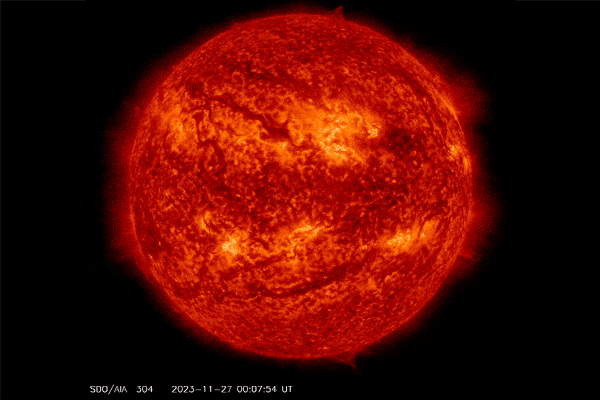November 29, 2023
3 min read
A solar outburst shoots charged particles into space—and toward Earth

A filament erupted from the sun on Nov. 27, 2023, and left a “canyon of fire” visible in the bottom right of this view.
A long filament of roiling plasma arcing over the sun’s surface snapped this week, leaving behind a scalding scar that has been dubbed a “canyon of fire.” It also spat a burst of solar plasma into space. There’s a chance this solar outburst and several that followed it could trigger minor geomagnetic storms on Earth.
The solar spectacle took place at midnight EST on November 27, according to the sun-monitoring website SpaceWeather.com. The canyon of fire remained in the sun’s soup of plasma, which is material so hot that it has lost all its electrons. This canyon of bright plasma traced the magnetic field line that had anchored the filament in place.
The canyon effect occurs because a filament is an arc of cooler, darker plasma that is anchored into the sun’s magnetic field on each end. When a filament erupts, the arc shatters into space, ripping free of the sun’s magnetic field to reveal a glowing scar of hotter, brighter plasma where that magnetic field line ran. (Filaments are sometimes called prominences when they occur along the edge of the sun, as seen from Earth, popping out as bright, wispy arcs against the blackness of space.)
The recent broken filament also triggered a coronal mass ejection (CME), scientist speak for a blob of plasma that the sun shoots into space. (In contrast, solar flares, another common type of outburst, are made up of radiation.) The CME was joined hours later by at least two more, according to SpaceWeather.com. And one of these was directed in the same general direction as the filament-triggered eruption, according to the National Oceanic and Atmospheric Administration’s Space Weather Prediction Center.
Once the plasma material makes its way nearer to us, it could disrupt Earth’s magnetosphere, the magnetic bubble surrounding our planet. This disruption is called a geomagnetic storm. NOAA has noted that it expects that just minor geomagnetic storms may result once the material makes its way toward Earth on November 30. Strong geomagnetic storms can paint the poles with auroras, but they can also interrupt satellite-based navigation systems and power grids on the surface.
Solar activity is governed by our sun’s 11-year cycle, which is intimately connected to its self-generated magnetic field. Currently, the sun’s magnetic poles are disappearing, heralding the peak of the solar activity cycle. In the coming years, as our star’s magnetic field rebuilds itself, solar activity—which is measured by tallies of the cold, dark sunspots that mar the sun’s surface—will ebb, and the next solar minimum, expected at the turn of the decade, will begin.
Scientists employ a host of tools to monitor the sun. Since the mid-1700s, astronomers have monitored sunspots with telescopes; NASA’s Solar Dynamics Observatory spacecraft, which captured the footage of the new broken filament included in this article, launched in 2010.
But as heliophysicists seek to understand how our star works, they have developed a trio of powerful new instruments that are gathering unprecedented observations this solar cycle: NASA’s Parker Solar Probe, which launched in 2018 and has flown closer to the sun than any other human-made object; the European Space Agency’s Solar Orbiter, which launched in 2020 and will let scientists peer at the sun’s poles; and the Daniel K. Inouye Solar Telescope in Hawaii, which produced its first images in 2020 and has given researchers a detailed view of our home star’s magnetic activity. The combination, scientists hope, will allow them to begin predicting in earnest how the sun’s activity influences life on Earth.




















































![[Spoiler] Gets Eliminated in First Live Show on Disney+ [Spoiler] Gets Eliminated in First Live Show on Disney+](https://www.tvinsider.com/wp-content/uploads/2022/09/dwts-premiere-1014x570.jpg)
